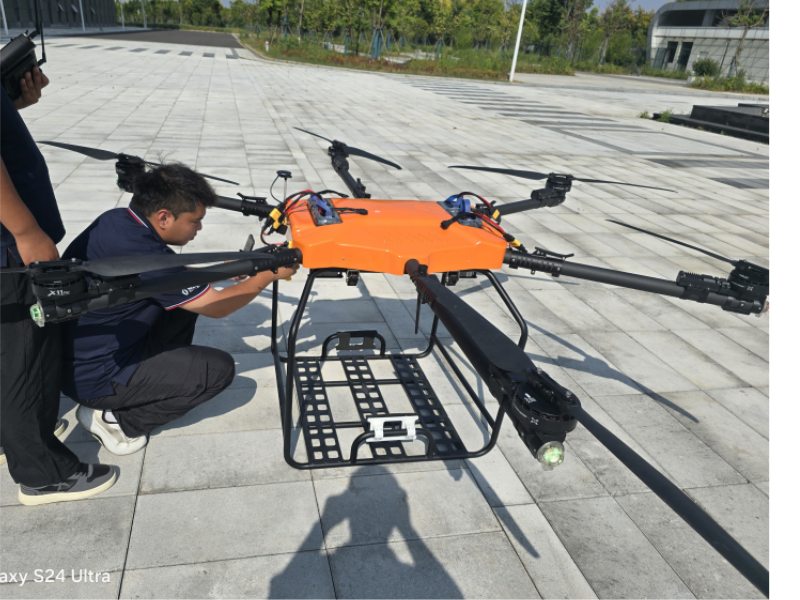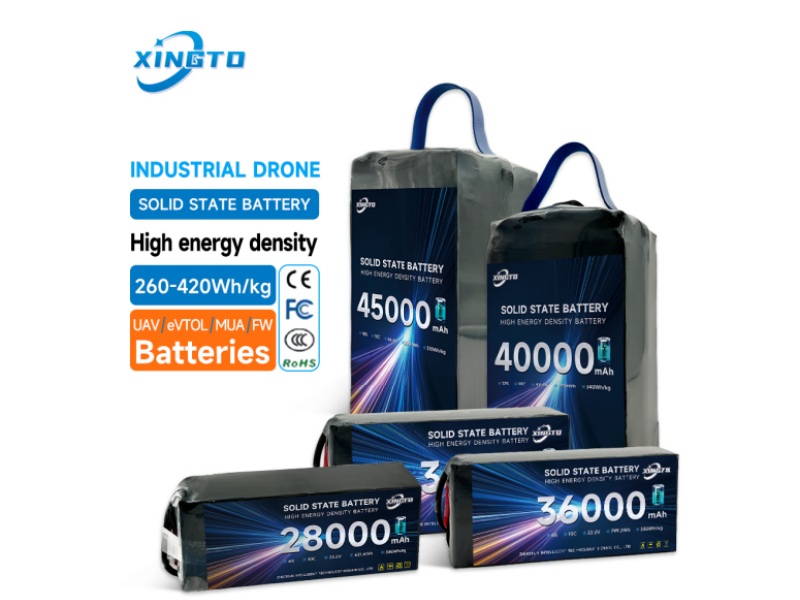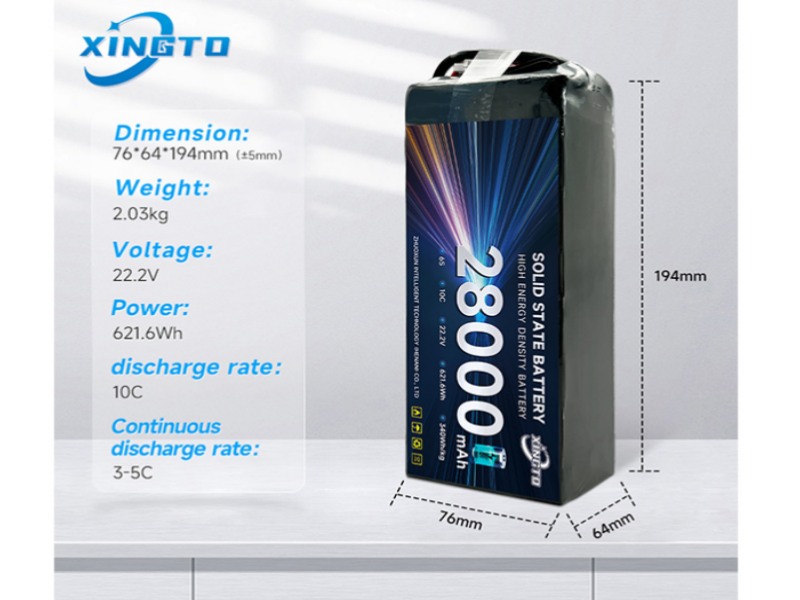Whether it is industrial drones, agricultural drones, or consumer drones, battery performance is one of the key factors affecting aircraft flight. Many users are confused about battery energy units (such as Wh, mAh) when choosing drone batteries, and are not sure how these parameters affect actual use. This article will provide a detailed analysis of the energy units and capacity parameters of drone batteries, helping you to scientifically select suitable drone batteries.

The main energy unit of drone batteries
Milliampere hour (mAh)
Milliampere hour (mAh) is the most common unit of battery capacity, indicating the time a battery can discharge at a specific current. For example:
A 5000mAh battery can be discharged for 10 hours at a current of 500mA or for 5 hours at a current of 1000mA.
characteristic:
✔ Intuitive and easy to understand, making it convenient to compare the capacity sizes of different batteries
✔ At the same voltage, the larger the mAh value, the longer the battery life
✖ It cannot reflect the actual energy of the battery alone and needs to be calculated in conjunction with the voltage
Watt hour (Wh)
Wh is a more scientific unit of energy that represents the total energy stored in a battery
Calculation formula: Wh=Voltage (V) × Capacity (mAh) ÷ 1000
Example:
3S lithium battery (11.1V) x 5000mAh=55.5Wh 4S lithium battery (14.8V) x 5000mAh=74Wh
Advantages:
✔ Can accurately reflect the actual energy storage capacity of the battery
✔ Convenient to compare the true endurance of batteries with different voltages
✔ Industry standard unit, commonly used for professional evaluation
Watt hour per kilogram (wh/kg)
The energy density unit Wh/kg (watt hours per kilogram) of a drone refers to the amount of electrical energy that the battery can store per unit weight. Specifically, Wh/kg represents the watt hours that can be stored per kilogram of material and is one of the important indicators for measuring battery energy density.
For example, if a battery has a capacity of 5000mAh and a mass of 1000g, its energy density is: energy density=5000mAh/1000g=5Wh/kg
Battery energy density is one of the important factors restricting the development of drones. High energy density batteries can provide longer endurance, thereby improving the operational efficiency and practicality of drones. For example, an energy density of 400Wh/kg is equivalent to twice the power of a conventional new energy vehicle battery and can support the flight of small general-purpose aircraft.

Detailed explanation of drone battery capacity parameters
Voltage (V)
Drone batteries are typically composed of multiple battery cells connected in series:
3S battery: 3 cells connected in series, voltage 11.1V (3.7V × 3)
4S battery: 4 battery cells in series, voltage 14.8V (3.7V × 4)
6S battery: 6 cells in series, voltage 22.2V (3.7V × 6)
influence:
✔ The higher the voltage, the faster the motor speed, and the stronger the power
✔ But it needs to match the rated voltage of the motor and the electric regulator
Capacity (mAh)
Common range: 1000mAh to 6000mAh
Consumer grade drones: mostly between 2000-4000mAh
Professional grade drone: capable of reaching 6000mAh or above
Suggestion for selection:
✔ Choose large capacity for high battery life requirements
✔ Choose small capacity for lightweight requirements
✔ Pay attention to the matching between battery weight and drone
C number (discharge rate)
Indicates the maximum discharge capacity of the battery:
C-number calculation: C-number=maximum discharge current ÷ rated capacity
Example: A 5000mAh 20C battery can provide 100A discharge current
influence:
✔ The higher the C-number, the stronger the instantaneous power
✔ But high C-number batteries are usually heavier and more expensive
✔ Consumer grade drones are generally sufficient at 10-20C
Energy density
Refers to the energy stored per unit weight or volume:
Wh/kg: measures the lightweight capability of batteries
Wh/L: measures the compactness of the battery
Trend:
✔ New generation batteries (such as semi-solid state batteries) have higher energy density
✔ Longer battery life under the same volume
| Number | Energy density/Full voltage | Model | L*W*T(±3mm) | Weight(±0.2kg) | Energy density | Full charge voltage | Voltage | Remark |
| 1 | 320Wh/kg 4.2V | ZXGT001-6S33AH | 90*67*217 mm | 2.60kg | 732.6wh | 25.2V | 22.2V | |
| 2 | ZXGT002-6S46AH | 49*145*255 mm | 3.47kg | 1021.2wh | 25.2V | 22.2V | ||
| 3 | ZXGT002-6S55AH | 56*145*255 mm | 4.16kg | 1221wh | 25.2V | 22.2V | ||
| 4 | ZXGT002-6S67AH | 62*145*255 mm | 5.01kg | 1487.4wh | 25.2V | 22.2V | ||
| 5 | ZXGT001-12S33AH | 130*90*217 mm | 4.95kg | 1465.2wh | 50.4V | 44.4V | ||
| 6 | ZXGT002-12S46AH | 90*150*255 mm | 6.95kg | 2042.4wh | 50.4V | 44.4V | ||
| 7 | ZXGT002-12S55AH | 106*145*255 mm | 8.32kg | 2442wh | 50.4V | 44.4V | ||
| 8 | ZXGT002-12S67AH | 128*145*255 mm | 10.02kg | 2974.8wh | 50.4V | 44.4V | ||
| 9 | ZXGT001-14S33AH | 158*90*217 mm | 6.06kg | 1709.4wh | 58.8V | 51.8V | ||
| 10 | ZXGT002-14S46AH | 108*145*255 mm | 8.21kg | 2382.8wh | 58.8V | 51.8V | ||
| 11 | ZXGT002-14S55AH | 130*145*255 mm | 9.70kg | 2849wh | 58.8V | 51.8V | ||
| 12 | ZXGT002-14S67AH | 151*145*255 mm | 11.65kg | 3470.6wh | 58.8V | 51.8V | ||
| 13 | ZXGT001-18S33AH | 195*90*217 mm | 7.46kg | 2197.8wh | 75.6V | 66.6V | ||
| 14 | ZXGT002-18S46AH | 130*145*255 mm | 10.43kg | 3063.6wh | 75.6V | 66.6V | ||
| 15 | ZXGT002-18S55AH | 158*145*255 mm | 12.48kg | 3663wh | 75.6V | 66.6V | ||
| 16 | ZXGT002-18S67AH | 188*145*255 mm | 15.03kg | 4462.2wh | 75.6V | 66.6V | ||
| 17 | ZXGT001-24S33AH | 130*182*222 mm | 19.50kg | 2930.4wh | 100.8V | 88.8V | ||
| 18 | ZXGT002-24S46AH | 194*145*255 mm | 13.90kg | 4084.8wh | 100.8V | 88.8V | (square) | |
| 19 | ZXGT002-24S55AH | 220*145*255 mm | 16.64kg | 4884wh | 100.8V | 88.8V | ||
| 20 | ZXGT002-24S67AH | 251*145*255 mm | 20.04kg | 5949.6wh | 100.8V | 88.8V |
Suggestions for selecting drone batteries
Calculate actual demand:
Calculate the required Wh based on flight duration requirements
For example, 30 minutes of battery life is required, and the battery needs to be ≥ 27.5Wh (assuming an average power of 55W)
Matching drone specifications:
Confirm the voltage range supported by the drone and pay attention to the maximum takeoff weight limit
Balance parameters:
Do not blindly pursue high capacity or high C-number, considering weight, cost, and performance comprehensively
Focus on brand and quality:
Choose products from reputable manufacturers and pay attention to the safety certification of batteries (such as CE, UL)
Common misconceptions when choosing drone batteries
think the larger the mAh, the better:
The actual endurance also depends on the voltage and drone efficiency
Ignore battery weight:
Large capacity batteries may increase the weight of drones and instead reduce their range
Confusing C number and battery life:
The C-number affects power performance and is not directly related to range
conclusion
Understanding the energy units (Wh, mAh) and capacity parameters (voltage, C-number, etc.) of drone batteries is the key to scientifically selecting drones. Consumers are advised to consider various parameters comprehensively based on their actual needs and choose the most suitable battery configuration for themselves.





